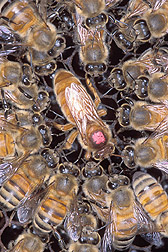| 
Closeup of Africanized honey bees surrounding a
European queen honey bee. Click the image for more information about
it.
Read the
magazine
story to find out more.
|
The Latest
Research on Africanized Honey Bees
By Kim Kaplan
March 2, 2004 While Hollywood has made Africanized
honey bees a frightening villain of mythic proportions since the 1950s, the
Agricultural Research Service has been
helping people learn the best ways to live with them in the real world.
Africanized honey bees (AHBs)--also melodramatically labeled "killer
bees"--are the result of honey bees brought from Africa to Brazil in 1956
in hopes of breeding a bee better adapted to the South American tropical
climate. They reached the Brazilian wilds in 1957 and then spread south and
north until they arrived in this country in 1990.
One of the most asked questions about AHBs has been how far they will spread
into the United States. In 14 years, they have reached five states--Texas,
Arizona, New Mexico, southern California and Nevada--as well as Puerto Rico and
the U.S. Virgin Islands.
ARS entomologist José D. Villa at the ARS
Honey Bee
Breeding, Genetics and Physiology Research Unit in Baton Rouge, La., has
found a correlation between rainfall of more than 55 inches, distributed evenly
throughout the year, and an almost complete barrier to AHB spread. He is far
from ready to confirm a cause-and-effect relationship, but the connection is
strong and he is planning research to look for the behavior or physiological
mechanism that may explain the relationship.
AHBs are more defensive, stinging more with less provocation than other
honey bees and thus making beekeeping more difficult. Honey bees and beekeeping
are essential to the country's agriculture, with pollination from bees
estimated to be worth $14 billion annually.
ARS entomologist Gloria DeGrandi-Hoffman at the
Carl Hayden Bee Research Center
in Tucson, Ariz., and her colleagues have found six biological and behavioral
factors that may be responsible for making AHBs such a successful invader in
areas to which they have spread. Armed with this information, they are working
on ways for beekeepers to maintain the more manageable European-descended honey
bees in AHB areas.
Read more about this research in the March issue of Agricultural Research
magazine.
ARS is the U.S. Department of
Agriculture's chief scientific research agency.
|